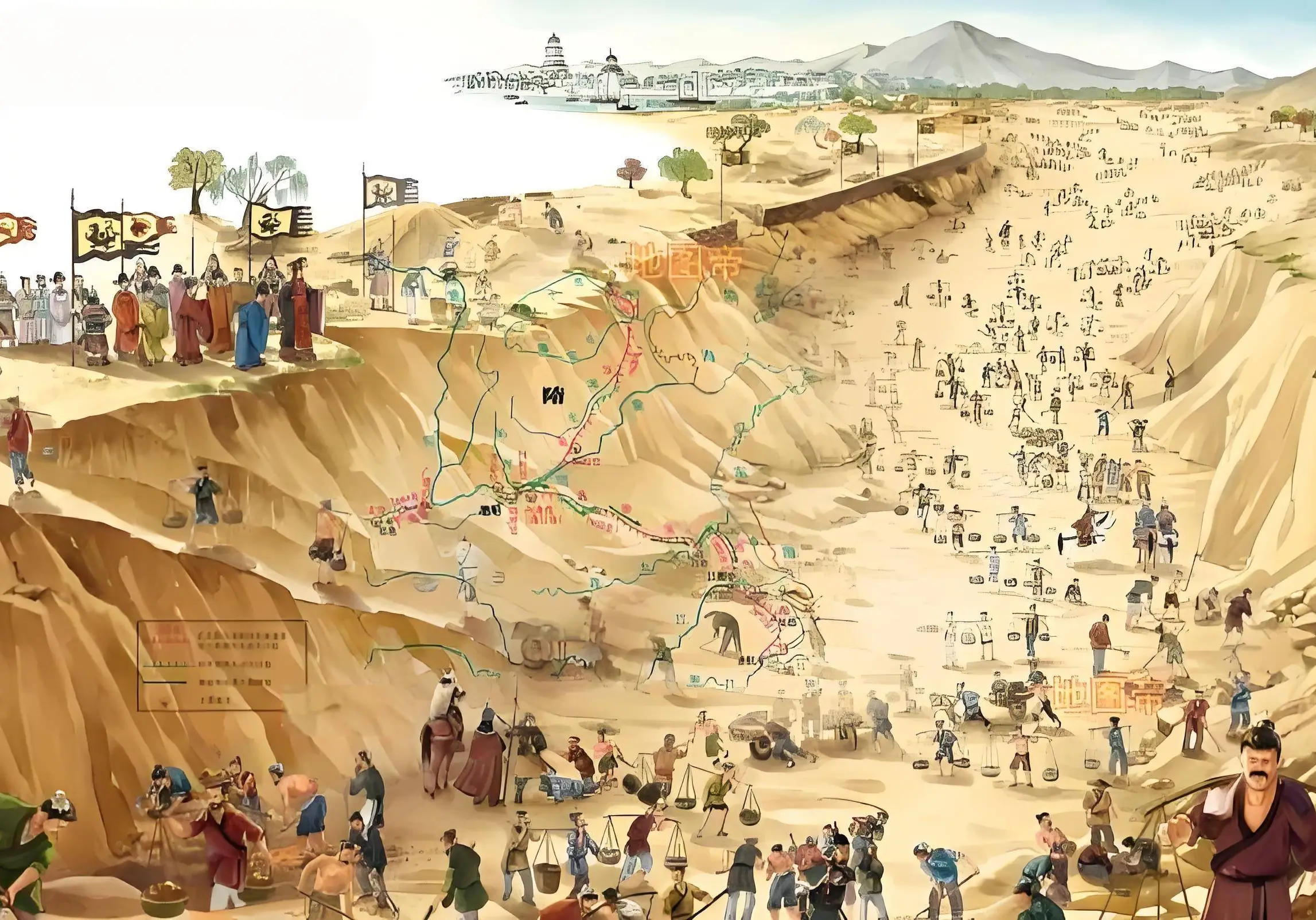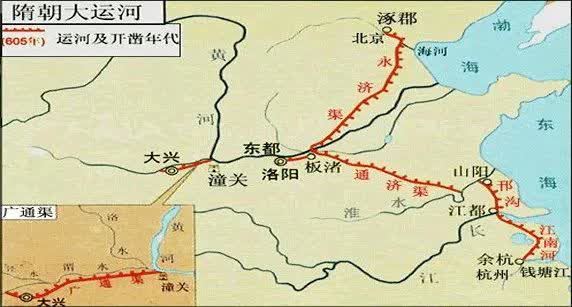Places that appear in the story Sui Yang Di Builds the Grand Canal
Luoyang City 洛阳城 - As the starting point of the Silk Road and a city with a population of over 1 million Luoyang was a thriving Metropolis during the Sui Dynasty. Indeed after declaring it as his new capital, Sui Yang Di began a massive
construction project in the city including a huge network of roads, buildings and canals. It was chosen as the starting point for his Grand Canal project which would connect Luoyang to all corners of the empire, including Yangzhou in the South.
Yangzhou 样州 - In Ancient China Yangzhou was a rough geographical area in the south of China that encompasses the modern Provinces of Zhejiang And Jiangsu. Therefore it includes the then, and now, prosperous and beautiful cities of Suzhou and Hangzhou among others.
Yangzhou, an area in the south of China (see places, below), flourished in the centuries before the Sui Dynasty and slowly China's economic centre of gravity shifted southwards. In 581 AD China was united, for the first time in nearly four centuries, and one of the most important objectives of the new ruling Sui Dynasty was to exert tighter administrative control over Yangzhou (Southern China).
It was also decided that, in order to unify the country further, improved trading links needed to be established between the southern region and the capital in Xi'an (later Luoyang). It was also hoped that goods could be transported from the south to the capital and then on further north to Beijing.
Daxing City 大兴城 The name in Chinese of this city means great excitement and it was made the capital of China. In the Tang Dynasty the name of the city was changed to Chang'an (长安), and it is now known as Xi'an.
The Central Plains 中原refers to the area around the Yellow River; in modern times including the provinces of Henan (including the Ancient capital Luoyang), HeBei, and Shandong. In the four centuries before the Sui Dynasty began in 581 AD the Central Plains were ravaged by wars as it passed hands between various ruling states and dynasties of China. Some of these ruling states and dynasties included the Wei 魏 (220-266 AD), Jin 晋 (266-420 AD), and the Northern and Southern Dynasties. As a result of these military conflicts the central plains and surrounding area had become severely damaged economically.
`
Characters from the story Sui Yang Di builds the Grand Canal (随杨帝开凿大运河)
Sui Yang Di (隋煬帝) -Emperor Yang (Yang Guang) was the second Emporor of the Sui Dynasty who ruled between the years 604 and 617 AD. He was a warrior who won many battles and embarked on many construction projects.
Emperor Sui Wen Di (隋文帝), original name Yang Jian (杨坚) - First Emperor of the Sui Dynasty and father of Sui Yang Di
Sui Yang Di builds the Grand Canal
The story Emperor Sui Yang Di builds the Grand Canal (随杨帝开凿大运河), is one that divides historians. Left wing historians portray Sui Yang Di as a selfish, tyrant out only to further his own glory with little interest in the wellbeing of the people or the country. This is how he has often been portrayed since post-1949 in Chinese school books. Their story of yáng guǎng 杨广, known to history as suí yáng dì 随杨帝, is as the ruler of the Sui Chinese dynasty between 569 and 618 AD. Whilst remembered in this version of history as a tyrannical leader, suí yáng dì随杨帝 is also credited for having launched several
important building initiatives such as extending the Great Wall and the construction of the Grand Canal.
However, the left claim the Emperor's motivation was to show off his power by travelling in style from Luoyang in the North of China to Yangzhou in the South. After coming to power Sui yang Di realised the potential of the Luoyang and made it the capital, replacing Xi'an and after claiming the throne he wanted to show off his strength by boat from his new capital, to the Southern region of YangZhou. Another interpretation of history is that Emporor Sui Yang Di was a visionary and that his work on the Grand Canal played a central role in creating a modern China; onelinked by trade and administration with the help of the Grand Canal.
Although, in both versions Sui Yang Di's rule was short-lived to one he was nothing more than a tyrant, to the other he laid the foundations for the hugely successful Tang Dynasty which came shortly after his death, and Sui Yang Di laid the foundations modern China to grow and flourish.

Historical Background to the Story Sui Yang Di builds the Grand Canal
Although in China Canals had been built since the 5th century AD, there had never been any attempt to connect these waterways until the Sui Dynasty. In order to solve the problem of transporting crops such as wheat, rice, corn and beans, to his new capital DaXing City (大兴城), in 584 Sui Wen Di ordered the construction of what would become the first part of the Grand Canal. These crops would be sent from the provinces to the Capital city as tribute, or tax if you prefer. Digging began to the North-west of DaXing City where a stretch of canal was started by digging a channel to divert water from the Wei River 渭河 (formerly known as Wei Shui 渭水). On completion this channel, which would become the first leg of the Grand Canal, would stretch eastwards over 150 kilometres to connect with the Yellow River at Tongguan. By connecting to the Yellow River the waterways connected the capital of Daxing to towns and cities all the way to the sea. In the year 604 this stretch of can was named Yong Tong Canal 永通渠
You can see the first stretch of the canal, Yong Tong Canal 永通渠, between DaXing City (大兴城) and Tongguan illustrated and highlighted within the orange box on the map, below.

Sui Yang Di (隋煬帝) Builds the Grand Canal
In 605 AD, the first year of Sui Yang Di's reign, he recruited an army of soldiers and workers to begin construction of the Tongji Canal 通济渠. The aim of this canal system was to faciliate trade, communications and administration of the southern areas of China. It would ultimately connect the Yellow River in the central plans to the Huai River (淮河) at Yangzhou City (扬州市). In the same year, 605 AD, the Three years later in 608 Ad, the fourth year of Emperor Sui Yand Di's reign he mobilised anoother million man army of workers, mostly from farming stock, to build the YongJi Canal (永济渠). The direction of this canal would be northwards and extended all the way to 涿郡 Zhoujun, which is modern day Beijing. This would link the new capital of Luoyang to Beijing.thinvolved diverting connect rivers and transport goods since 5th century AD, there had never been any attempt to connect the various sections before the Sui Dynasty. The Grand Canal built to consolidate trade between Northern and Southern China, stretched from modern Hangzhou at that time called Yuhang (余杭) in the south, to with Luoyang (洛阳) in the east, and then on to Beijing (涿郡) in the North